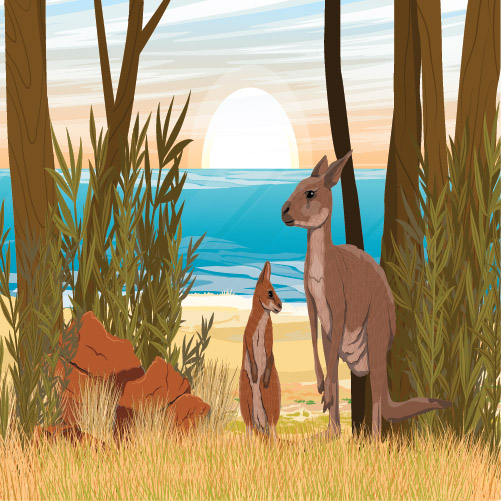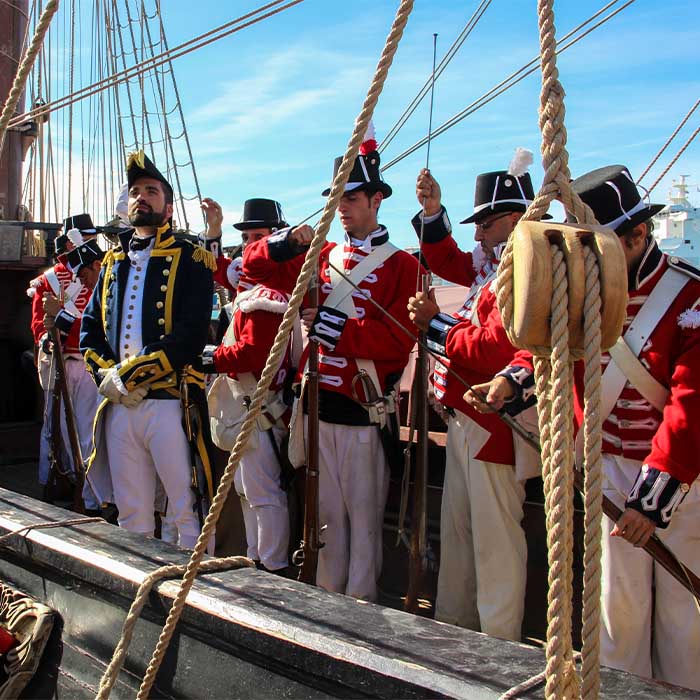Y4. L19. Present historical Australian songs
Prior learning: None
Duration: 30 minutes
Materials: Woodblocks or claves
Keywords: Beat, rhythm, singing, chanting, partners, rhymes, circle games.
Difficulty: ![]()
Prepare
Percussion family
Present
Historical Australian songs
Practise

Australian historical folk songs hold deep cultural and historical significance, as they reflect the experiences, struggles, and values of the people who shaped the country. These songs were often passed down orally, serving as a record of life during early colonisation, the gold rush, and the frontier periods. They capture the hardships of convict labour, the resilience of bushmen, and the challenges faced by Indigenous Australians, offering a glimpse into the diverse perspectives of Australia's past.
Songs like "Waltzing Matilda" tell the story of itinerant workers, known as swagmen, providing insight into the nomadic lifestyles of those seeking opportunities in the bush. "Bound for South Australia", a sea shanty, reflects the experiences of sailors and early settlers who braved long, dangerous voyages to reach the new colony. "Ryebuck Shearer" highlights the wool industry, a crucial part of Australia’s economy and identity.
These folk songs also foster a sense of national pride and unity, giving Australians a shared history through music. They immortalise the endurance and strength of the people who lived through these times, preserving Australia's unique cultural identity. Today, they remain a valuable tool for teaching history and fostering a connection to the past.
 Melodic development
Melodic development
![]() Students are introduced to songs from early settlers in Australia.
Students are introduced to songs from early settlers in Australia.

Ask students, "What makes a song special to a country or its people?"
- Explain that songs often tell stories about the past, including people's lives, work, struggles, and celebrations.
- Introduce the idea of Australian folk songs, explaining that many were sung by early settlers, workers, and Indigenous people to express their experiences.
Discuss the three songs below.
"Bound for South Australia" – A sea shanty sung by sailors travelling to South Australia.
- Play the song, introducing it as a sea shanty sung by sailors to pass the time while working on ships.
- Discuss the historical context: Early colonists and sailors often headed to South Australia, making long and difficult voyages.
- Teach the students the chorus and encourage them to sing along.
"Waltzing Matilda" – Explain that this song tells the story of a "swagman" (a travelling worker) and his adventures.
- Play the audio recording of the song.
- Discuss the meaning of key terms like "swagman" and "billabong."
- Have students sing along with the chorus, guiding them through the melody.
"Ryebuck Shearer" – A song about the life of a shearer, celebrating the hard work and tough lifestyle of those working in the wool industry.
- Play the song, explaining that it describes the life of a shearer, a common job in rural Australia during the late 19th and early 20th centuries.
Discuss the meaning of the term "Ryebuck" (meaning strong or sturdy) and why shearers were proud of their work. - Invite students to join in singing the chorus.
 Rhythmic development
Rhythmic development
![]() Students discover why rhythm is important when singing a sea shanty.
Students discover why rhythm is important when singing a sea shanty.

- Divide the class into two groups for the call & response in Bound For South Australia.
- Ask students, "What did you notice about the rhythm in this song?" and encourage them to share their observations.
- Illustrate the practical application of rhythm by explaining how it helped sailors keep pace with their jobs and how different rhythms can tell different stories.
- Explain how sea shanties kept sailors in rhythm while they worked. Ask why it was important that they worked to a rhythm [to work together as a team in hoisting the sails or hauling up the anchor]
 Creative movement
Creative movement
![]() Students act out the lives of sailors on a ship using coordinated group movements.
Students act out the lives of sailors on a ship using coordinated group movements.
- Arrange the students into 3-4 groups and assemble in rows as if aboard a ship. Each group of students represents a ship's crew.
- Play "Bound for South Australia" or sing with the class.
- Movements:
- Hauling Ropes: During the response in the verse ("Heave away, haul away"), students mimic pulling ropes in time with the beat, moving their arms in a pulling motion.
- Steering the Ship: One student in each group can pretend to steer the ship by turning an imaginary wheel and moving their body from side to side.
- Rocking on Waves: In the chorus, students can sway from side to side, pretending the ship is rocking on the ocean waves.
- Sailor's Work: Students can mimic climbing the mast, adjusting the sails, and other ship tasks in rhythm with the music
- This game encourages teamwork as each "crew" works together to keep the ship moving. You can call out specific actions like "hoist the sails", "steer the ship," or "look for pirates," prompting students to switch roles and movements.
 Listening
Listening
![]() Students listen to examples of the percussion family to discover the instrument.
Students listen to examples of the percussion family to discover the instrument.
- This exercise is to prepare students for the orchestra's percussion family.
- Play the first track and ask the name of the instrument that is heard [bass drum].
- Ask where this instrument is found [orchestra]. Note: it is easy to mistake the kick drum of a drum kit for an orchestral bass drum!
- Ask what materials the instrument is made from.
- Repeat the process with each of the following tracks.
- At the conclusion, ask what these instruments have in common [they all need to be struck].
 Visual learning
Visual learning
![]() Students discover three instruments often used ib historical songs from Australia.
Students discover three instruments often used ib historical songs from Australia.
- Project the image using the full-screen mode.
- There are three manikins [dummies], each holding an instrument used in the days of the early settlers.
- Ask if anyone recognises what instruments are shown. [guitar, banjo and tea-chest bass]
- Discuss the tea chest bass. It was a makeshift instrument created from a wooden tea chest (or half a wooden barrel), a broomstick, and a piece of string or wire. It made a deep, rhythmic bass sound, particularly in informal gatherings and bush bands.
- Ask which of these instruments can be commonly found today.
 Instruments
Instruments
![]() Students
Students
 Part work
Part work
![]() Students practise conducting in quadruple metre.
Students practise conducting in quadruple metre.
- Lead the class in singing the song.
- A good example song might be Ah Poor Bird, which has a slow tempo and allows for practice of the harmonic minor scale.
- Sing and demonstrate the beat conducting pattern of quadruple metre to students, who should mirror your actions.
 Assess
Assess
Suggested lessons
Y1. Beat II

Y1. Beat III

Y1. Beat IV

